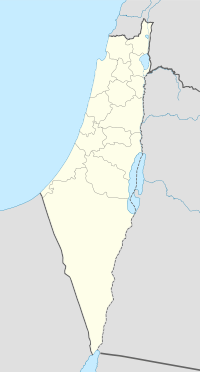Umm az-Zinat
| Umm az Zinat | |
|---|---|
| Arabic | أُم الزينات |
| Name meaning | the place of ornamentation or of festivals |
| Subdistrict | Haifa |
| Coordinates | 32°38′50″N 35°03′47.8″E / 32.64722°N 35.063278°ECoordinates: 32°38′50″N 35°03′47.8″E / 32.64722°N 35.063278°E |
| Palestine grid | 156/228 |
| Population | 1,470 (1945) |
| Area | 22,156 dunams |
| Date of depopulation | May 1948 |
| Cause(s) of depopulation | Fear of being caught up in the fighting |
| Current localities | Eliakim |
Umm az-Zinat (Arabic: أُم الزينات, Umm ez Zînât) was a Palestinian Arab village in the Haifa Subdistrict. It was depopulated during the 1948 War on May 15, 1948 by Golani Brigade's Fourth Battalion. It was located 20.5 km southeast of Haifa.
Several rock cut tombs were found south and south west of the village. They have been dated to the Christian era.
In 1859, the English Consul Rogers stated that the population was 350 souls, with 25 feddans of cultivation.
In 1870, Victor Guérin found the village to have four hundred and fifty inhabitants. Some gardens were surrounded by a cactus. The medhafeh, or guest house, also served as a mosque.
In 1882, the Palestine Exploration Fund's Survey of Western Palestine (SWP) described the village as: "A good-sized village on a saddle, built principally of stone, with a well on the south. This seems to be an ancient site, having many well-cut rock-tombs."
A population list from about 1887 showed that Umm ez-Zeinat had about 750 inhabitants; all Muslims.
Umm al-Zinat had an elementary school for boys which was founded by the Ottomans in 1888.
In the 1922 census of Palestine Umm al-Zainat had a population of 787; 782 Muslims and 5 Christians, where the Christians were all Melkite. This had increased in the 1931 census to 1,020 Muslims and 9 Christians, in a total of 209 houses.
In 1945, the village had a population of 1,470; 1,450 Muslims and 20 Christians, with a total of 22,156 dunams of land. Of this, 1,742 dunums of land were for plantations and irrigable land, 9,879 for cereals, while 69 dunams were classified as built-up land.
...
Wikipedia

